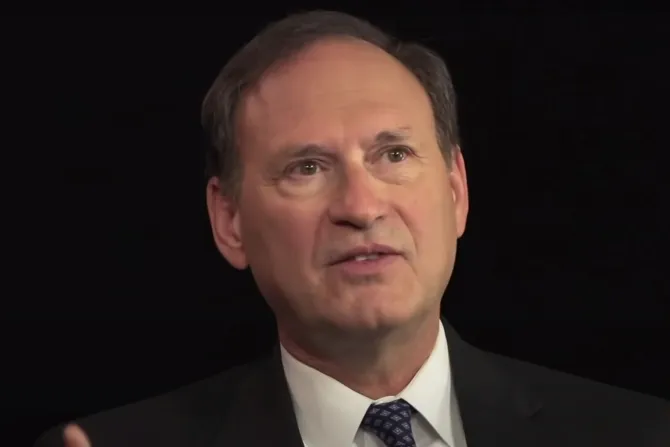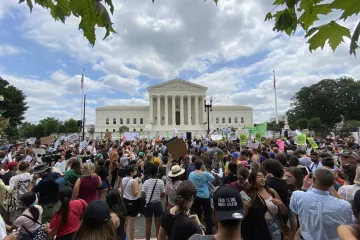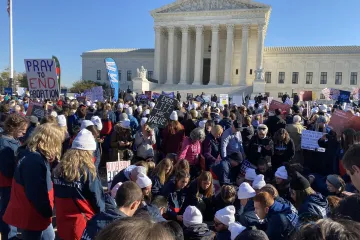Denver Newsroom, Jun 24, 2022 / 12:08 pm
The Supreme Court has overturned Roe v. Wade, saying that previous abortion rulings were “egregiously wrong from the start” and on a “collision course with the Constitution.” Roe and other pro-abortion rights precedents were “an error that cannot be allowed to stand,” and the abortion debate must now return to the states.
The June 24 decision, authored by Justice Samuel Alito, concerned a 15-week abortion ban in Mississippi under the name Dobbs v. Jackson Women’s Health Organization. It often echoes a draft decision leaked in May that thoroughly rebuked the pro-abortion decisions Roe v. Wade and Planned Parenthood v. Casey, respectively issued in 1973 and 1992 by Republican-majority courts.
Alito’s decision was joined by Justices Clarence Thomas, Neil Gorsuch, Brett Kavanaugh, and Amy Coney Barrett. Thomas and Kavanaugh also filed concurring opinions.
Chief Justice John Roberts filed an opinion concurring in the judgement, in which he advocated for a more narrow ruling. All justices who backed the decision were nominated by Republican presidents. However, the decision cites President John F. Kennedy appointee Justice Byron White’s dissent in the Roe decision.
The Dobbs case drew dissents from Justices Stephen Breyer, Elena Kagan, and Sonia Sotomayor, all appointees of Democratic presidents.
Here are some key passages from Alito’s decision, followed by Robert's concurrence, rebuttals from Alito, and the dissent.
Mandatory legal abortion is overruled; the debate goes back to the states
“Abortion presents a profound moral question. The Constitution does not prohibit the citizens of each State from regulating or prohibiting abortion,” the decision says. “Roe and Casey arrogated that authority. The Court overrules those decisions and returns that authority to the people and their elected representatives.”
“We hold that Roe and Casey must be overruled. The Constitution makes no reference to abortion, and no such right is implicitly protected by any constitutional provision, including the one on which the defenders of Roe and Casey now chiefly rely—the Due Process Clause of the Fourteenth Amendment.”
It’s about human life: Abortion 'fundamentally different' than related court decisions
Abortion is “fundamentally different” from other decisions related to sexual relations, contraception, and marriage because it destroys what other court decisions call “fetal life” and what the Mississippi law in question describes as an “unborn human being.”
“None of the other decisions cited by Roe and Casey involved the critical moral question posed by abortion.”
Roe v. Wade: 'Egregiously wrong from the start'
The legal principle of stare decisis, which advises that precedent should usually stand, “does not compel unending adherence to Roe’s abuse of judicial authority.”
“Roe was egregiously wrong from the start. Its reasoning was exceptionally weak, and the decision has had damaging consequences. And far from bringing about a national settlement of the abortion issue, Roe and Casey have enflamed debate and deepened division,” said Alito’s decision.
Women’s voices on abortion must be heard through legislatures and the ballot box
(Story continues below)
“Our decision returns the issue of abortion to those legislative bodies, and it allows women on both sides of the abortion issue to seek to affect the legislative process by influencing public opinion, lobbying legislators, voting, and running for office. Women are not without electoral or political power. It is noteworthy that the percentage of women who register to vote and cast ballots is consistently higher than the percentage of men who do so,” said the Dobbs decision.
The states have 'legitimate interests' in regulating abortion
The majority decision said, “procuring an abortion is not a fundamental constitutional right because such a right has no basis in the Constitution’s text or in our Nation’s history.”
“It follows that the States may regulate abortion for legitimate reasons, and when such regulations are challenged under the Constitution, courts cannot ‘substitute their social and economic beliefs for the judgment of legislative bodies’.”
A law regulating abortion, like other health and welfare laws, is entitled to a “strong presumption of validity” if there is “a rational basis on which the legislature could have thought that it would serve legitimate state interests.”
“These legitimate interests include respect for and preservation of prenatal life at all stages of development; the protection of maternal health and safety; the elimination of particularly gruesome or barbaric medical procedures; the preservation of the integrity of the medical profession; the mitigation of fetal pain; and the prevention of discrimination on the basis of race, sex, or disability,” the decision explains.
Roe v. Wade was 'on a collision course with the Constitution' from day one
“Roe’s constitutional analysis was far outside the bounds of any reasonable interpretation of the various constitutional provisions to which it vaguely pointed.”
“Roe was on a collision course with the Constitution from the day it was decided, Casey perpetuated its errors, and those errors do not concern some arcane corner of the law of little importance to the American people.”
“Rather, wielding nothing but ‘raw judicial power,’ the Court usurped the power to address a question of profound moral and social importance that the Constitution unequivocally leaves for the people.”
“Casey described itself as calling both sides of the national controversy to resolve their debate, but in doing so, Casey necessarily declared a winning side. Those on the losing side—those who sought to advance the State’s interest in fetal life—could no longer seek to persuade their elected representatives to adopt policies consistent with their views. The Court short-circuited the democratic process by closing it to the large number of Americans who dissented in any respect from Roe…. Together, Roe and Casey represent an error that cannot be allowed to stand.”
Abortion precedents relied on bad history and bad reasoning
The right to abortion was “entirely unknown in American law” until the latter part of the 20th century, said Alito’s decision.
“Indeed, when the Fourteenth Amendment was adopted, three quarters of the States made abortion a crime at all stages of pregnancy.”
“The weaknesses in Roe’s reasoning are well-known. Without any grounding in the constitutional text, history, or precedent, it imposed on the entire country a detailed set of rules much like those that one might expect to find in a statute or regulation…. The scheme Roe produced looked like legislation, and the Court provided the sort of explanation that might be expected from a legislative body… What Roe did not provide was any cogent justification for the lines it drew.”
“The Constitution makes no express reference to a right to obtain an abortion, and therefore those who claim that it protects such a right must show that the right is somehow implicit in the constitutional text… Roe, however, was remarkably loose in its treatment of the constitutional text.”
“Roe’s reasoning was exceedingly weak, and academic commentators, including those who agreed with the decision as a matter of policy, were unsparing in their criticism,” said the decision. Among those it cites is Roe critic Laurence Tribe, a Harvard Law School professor emeritus who supports legal abortion.
Roe was a groundless novelty because many U.S. states banned abortion
“Until the latter part of the 20th century, there was no support in American law for a constitutional right to obtain an abortion. No state constitutional provision had recognized such a right. Until a few years before Roe, no federal or state court had recognized such a right. Nor had any scholarly treatise. Indeed, abortion had long been a crime in every single State. At common law, abortion was criminal in at least some stages of pregnancy and was regarded as unlawful and could have very serious consequences at all stages. American law followed the common law until a wave of statutory restrictions in the 1800s expanded criminal liability for abortions. By the time the Fourteenth Amendment was adopted, three-quarters of the States had made abortion a crime at any stage of pregnancy. This consensus endured until the day Roe was decided. Roe either ignored or misstated this history, and Casey declined to reconsider Roe’s faulty historical analysis. It is therefore important to set the record straight,” said the Dobbs decision, before providing its own overview of the legal history of abortion.
“The inescapable conclusion is that a right to abortion is not deeply rooted in the Nation’s history and traditions. On the contrary, an unbroken tradition of prohibiting abortion on pain of criminal punishment persisted from the earliest days of the common law until 1973.”
The Supreme Court can’t settle the abortion debate, but legislators may
“It is time to heed the Constitution and return the issue of abortion to the people’s elected representatives.”
“This Court’s inability to end debate on the issue should not have been surprising. This Court cannot bring about the permanent resolution of a rancorous national controversy simply by dictating a settlement and telling the people to move on. Whatever influence the Court may have on public attitudes must stem from the strength of our opinions, not an attempt to exercise ‘raw judicial power’.”
Chief Justice Roberts concurs in the judgement, but calls it ‘a serious jolt’
Chief Justice John Roberts voted with the majority, but filed a concurring opinion in which he criticized Roe but also advocated for a more narrow ruling in Dobbs.
"The Court’s decision to overrule Roe and Casey is a serious jolt to the legal system—regardless of how you view those cases," his opinion reads. "A narrower decision rejecting the misguided viability line would be markedly less unsettling, and nothing more is needed to decide this case."
"My point is that Roe adopted two distinct rules of constitutional law: one, that a woman has the right to choose to terminate a pregnancy; two, that such right may be overridden by the State’s legitimate interests when the fetus is viable outside the womb," he added at another point. "The latter is obviously distinct from the former. I would abandon that timing rule, but see no need in this case to consider the basic right."
Roberts agrees that Roe got a lot wrong
“This Court seriously erred in Roe in adopting viability as the earliest point at which a State may legislate to advance its substantial interests in the area of abortion…neither Roe nor Casey made a persuasive or even colorable argument for why the time for terminating a pregnancy must extend to viability.”
Roberts faults both majority opinion and dissent; asks whether compromise was possible
“Both the Court’s opinion and the dissent display a relentless freedom from doubt on the legal issue that I cannot share. I am not sure, for example, that a ban on terminating a pregnancy from the moment of conception must be treated the same under the Constitution as a ban after fifteen weeks.”
“Here, there is a clear path to deciding this case correctly without overruling Roe all the way down to the studs: recognize that the viability line must be discarded, as the majority rightly does, and leave for another day whether to reject any right to an abortion at all.”
Roberts promoted “adherence to a simple yet fundamental principle of judicial restraint: If it is not necessary to decide more to dispose of a case, then it is necessary not to decide more.”
The Dobbs justices counter: Roberts’ concurrence has ‘serious problems’
“There are serious problems with this approach, and it is revealing that nothing like it was recommended by either party. As we have recounted, both parties and the Solicitor General have urged us either to reaffirm or overrule Roe and Casey,” the majority opinion said.
And when the specific approach advanced by the concurrence was broached at oral argument, both respondents and the Solicitor General emphatically rejected it. Respondents’ counsel termed it “completely unworkable” and “less principled and less workable than viability.”
“The concurrence would do exactly what it criticizes Roe for doing: pulling ‘out of thin air’ a test that ‘[n]o party or amicus asked the Court to adopt’.”
Roberts’ concurrence needed to argue on constitutional principle
“The concurrence’s most fundamental defect is its failure to offer any principled basis for its approach,” the majority opinion continued.
‘…stare decisis cannot justify the new ‘reasonable opportunity’ rule propounded by the concurrence. If that rule is to become the law of the land, it must stand on its own, but the concurrence makes no attempt to show that this rule represents a correct interpretation of the Constitution. The concurrence does not claim that the right to a reasonable opportunity to obtain an abortion is ‘deeply rooted in this Nation’s history and tradition’ and ‘implicit in the concept of ordered liberty.’
“Nor does it propound any other theory that could show that the Constitution supports its new rule. And if the Constitution protects a woman’s right to obtain an abortion, the opinion does not explain why that right should end after the point at which all ‘reasonable’ women will have decided whether to seek an abortion.”
A ‘compromise’ would only prolong national turmoil over abortion
“The concurrence’s quest for a middle way would only put off the day when we would be forced to confront the question we now decide. The turmoil wrought by Roe and Casey would be prolonged. It is far better—for this Court and the country—to face up to the real issue without further delay,” the majority opinion responded.
Dissent: Women rely on abortion as part of their self-determination, and even identity
The three dissenting justices in Dobbs emphasized the role abortion has played in American life.
“As Casey understood, people today rely on their ability to control and time pregnancies when making countless life decisions: where to live, whether and how to invest in education or careers, how to allocate financial resources, and how to approach intimate and family relationships.”
“Taking away the right to abortion, as the majority does today, destroys all those individual plans and expectations. In so doing, it diminishes women’s opportunities to participate fully and equally in the Nation’s political, social, and economic life,” the dissent said, adding “the expectation of reproductive control is integral to many women’s identity and their place in the Nation.”
Pro-abortion rights precedents “have protected the liberty and equality of women” and reaffirmed that “the Constitution safeguards a woman’s right to decide for herself whether to bear a child… the government could not control a woman’s body or the course of a woman’s life: It could not determine what the woman’s future would be.”
“Respecting a woman as an autonomous being, and granting her full equality, meant giving her substantial choice over this most personal and most consequential of all life decisions,” the dissent said.
Ending Roe means ‘forced pregnancy’ and ‘forced birth,’ dissenting justices say
“As of today, this Court holds, a State can always force a woman to give birth, prohibiting even the earliest abortions. A State can thus transform what, when freely undertaken, is a wonder into what, when forced, may be a nightmare,” said the dissent.
In its view, the court majority says “that from the very moment of fertilization, a woman has no rights to speak of. A State can force her to bring a pregnancy to term, even at the steepest personal and familial costs. An abortion restriction, the majority holds, is permissible whenever rational, the lowest level of scrutiny known to the law. And because, as the Court has often stated, protecting fetal life is rational, States will feel free to enact all manner of restrictions.”
“The majority would allow States to ban abortion from conception onward because it does not think forced childbirth at all implicates a woman’s rights to equality and freedom. Today’s Court, that is, does not think there is anything of constitutional significance attached to a woman’s control of her body and the path of her life.”
Dissenting justices back abortion of disabled unborn
“So too, after today’s ruling, some States may compel women to carry to term a fetus with severe physical anomalies—for example, one afflicted with Tay-Sachs disease, sure to die within a few years of birth,” said the dissent.
Dissent cites ‘hard’ cases of rape, mother’s health or life endangered
The dissent warned of states which “have passed laws without any exceptions for when the woman is the victim of rape or incest. Under those laws, a woman will have to bear her rapist’s child or a young girl her father’s—no matter if doing so will destroy her life.”
“States may even argue that a prohibition on abortion need make no provision for protecting a woman from risk of death or physical harm,” the dissent added. “Across a vast array of circumstances, a State will be able to impose its moral choice on a woman and coerce her to give birth to a child.”
Fears of national legal bans on abortion
“Most threatening of all, no language in today’s decision stops the Federal Government from prohibiting abortions nationwide, once again from the moment of conception and without exceptions for rape or incest,” said the dissent.
Are the principles of legal abortion at the core of American freedom?
“Roe and Casey were from the beginning, and are even more now, embedded in core constitutional concepts of individual freedom, and of the equal rights of citizens to decide on the shape of their lives,” said the dissent. “Those legal concepts, one might even say, have gone far toward defining what it means to be an American. For in this Nation, we do not believe that a government controlling all private choices is compatible with a free people.”
Personal freedoms a ‘Jenga tower’ at risk from Dobbs
The dissent praised the Roe decision’s concept of “personal liberty” Fourteenth Amendment protections for individual decisions about marriage, procreation, contraception, family relationships, child rearing and education.
“The Court’s precedents about bodily autonomy, sexual and familial relations, and procreation are all interwoven—all part of the fabric of our constitutional law, and because that is so, of our lives. Especially women’s lives, where they safeguard a right to self-determination.”
The majority’s claim that contraception is not endangered is an unwarranted effort to “pick and choose.” The dissent also invoked precedents ending bans on interracial marriage and same-sex “marriage,” saying that these too represented constitutional protections for private decisions.
In the dissent’s view, the majority decision claims to be able to “neatly extract the right to choose from the constitutional edifice without affecting any associated rights. (Think of someone telling you that the Jenga tower simply will not collapse.)”
Dissent sees ‘balance’ in now-overturned pro-abortion rights precedents
For the critics of the Dobbs decision, Roe and Casey recognized both “the state interest in protecting prenatal life” and that “a woman’s freedom and equality are likewise involved.”
“In the first trimester of pregnancy, the State could not interfere at all with the decision to terminate a pregnancy. At any time after that point, the State could regulate to protect the pregnant woman’s health, such as by insisting that abortion providers and facilities meet safety requirements.” After fetal viability, “the State could ban abortions, except when necessary to preserve the woman’s life or health.”
For dissenting judges, America’s framers are limited but also progressive
Appeals to original intent or other precedents of history are misguided for several reasons, including because originally women were not recognized as full citizens, the dissent said.
The framers of American law “understood that the world changes. So they did not define rights by reference to the specific practices existing at the time. Instead, the Framers defined rights in general terms, to permit future evolution in their scope and meaning. And over the course of our history, this Court has taken up the Framers’ invitation. It has kept true to the Framers’ principles by applying them in new ways, responsive to new societal understandings and conditions.”
In the dissent’s view, “applications of liberty and equality can evolve while remaining grounded in constitutional principles, constitutional history, and constitutional precedents.”
Dissent sees more conflicts to come, on abortion and other laws
“Can a State bar women from traveling to another State to obtain an abortion? Can a State prohibit advertising out-of-state abortions or helping women get to out-of-state providers?” the dissent asked. “Can a State interfere with the mailing of drugs used for medication abortions? The Constitution protects travel and speech and interstate commerce, so today’s ruling will give rise to a host of new constitutional questions. Far from removing the Court from the abortion issue, the majority puts the Court at the center of the coming “interjurisdictional abortion wars.”
Dissenters say facts are on the side of legal abortion
“Subsequent legal developments have only reinforced Roe and Casey,” said the dissenting justices, who argued “no subsequent factual developments have undermined Roe and Casey.” Abortion law under Roe was more aligned with that of other countries,
“Women continue to experience unplanned pregnancies and unexpected developments in pregnancies. Pregnancies continue to have enormous physical, social, and economic consequences,” they said, particularly faulting “abysmal” health outcomes in Mississippi, the state which brought the case.
“Roe and Casey continue to reflect, not diverge from, broad trends in American society. It is, of course, true that many Americans, including many women, opposed those decisions when issued and do so now as well. Yet the fact remains: Roe and Casey were the product of a profound and ongoing change in women’s roles in the latter part of the 20th century,” said the dissent.
The justices predicted “profound” disruption from overturning Roe: “Abortion is a common medical procedure and a familiar experience in women’s lives. About 18 percent of pregnancies in this country end in abortion, and about one quarter of American women will have an abortion before the age of 45.”
This is a developing story.






